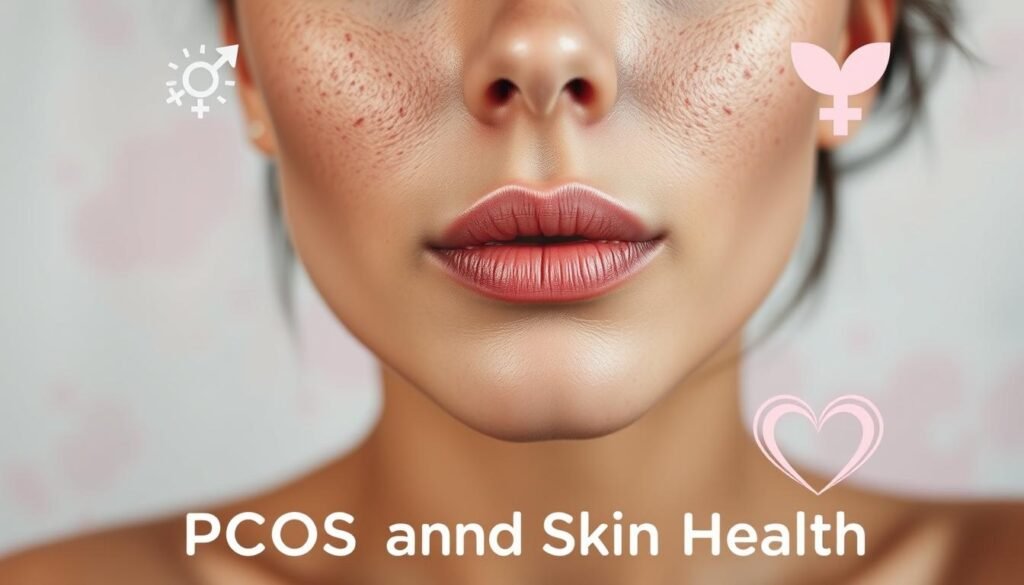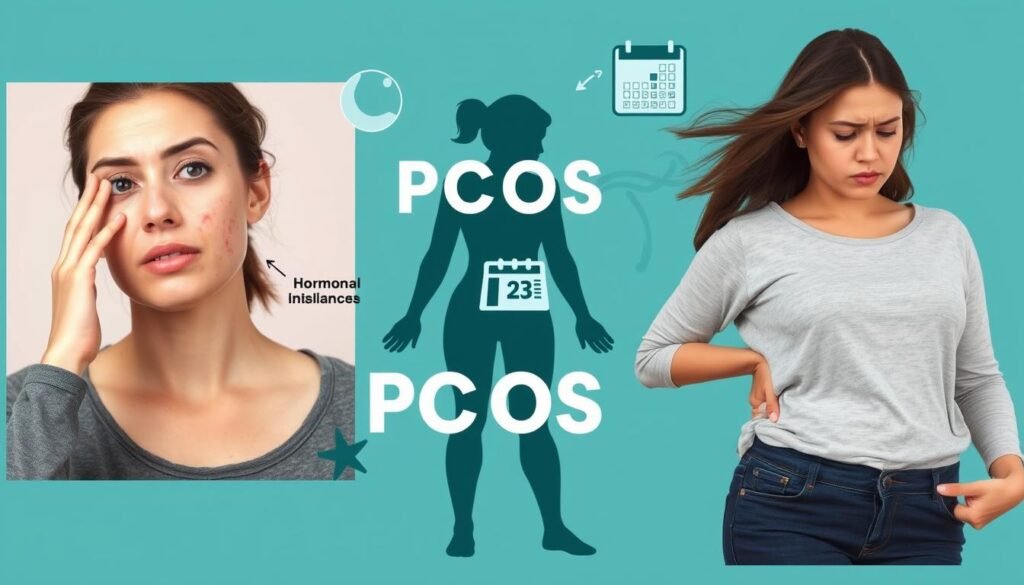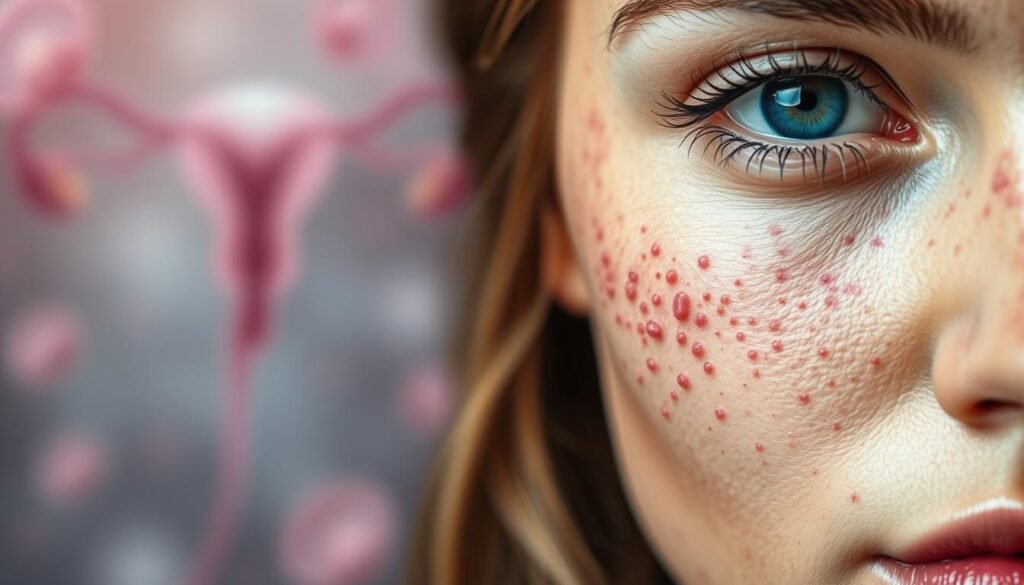About 10% of women at childbearing age have Polycystic Ovary Syndrome (PCOS). It’s the most common issue of its kind. This makes it vital to understand how PCOS links to acne. At the core of PCOS is a hormonal imbalance. It messes with the body’s normal workings and causes skin issues like hormonal acne. We will look into how these hormonal changes lead to breakouts. Plus, we’ll discuss how to treat acne when dealing with PCOS.
Key Takeaways
- PCOS affects about 10% of women of reproductive age, leading to various symptoms including acne.
- Hormonal imbalance is a core aspect that triggers skin issues associated with PCOS.
- Oral contraceptives often improve acne for many individuals by stabilizing hormone levels.
- Diet and lifestyle changes can play a significant role in managing both PCOS and acne.
- Hormonal acne typically appears lower on the face, especially on the chin and jawline.
What is Polycystic Ovary Syndrome (PCOS)?
Polycystic Ovary Syndrome (PCOS) affects about 10% of women at childbearing age. It’s a hormonal disorder marked by irregular periods and high levels of androgens. Those with PCOS often face irregular menstrual cycles, acne, infertility, and lots of hair growth.
Women with PCOS might have insulin resistance. This makes insulin and androgen levels go up. Having PCOS in the family, being overweight, and insulin problems are big risk factors. These issues can make conditions like diabetes and high blood pressure worse.
Treating PCOS depends on a few things. These include your age, symptom severity, and if you want to have kids. Treatments can involve diet and exercise changes, medication to help with ovulation, and birth control pills. Knowing about PCOS is key to managing it well.
| PCOS Symptoms | Description |
|---|---|
| Irregular Periods | Missed or infrequent menstruation |
| Acne | Severe breakouts often associated with hormonal changes |
| Hirsutism | Excessive hair growth on the face and body |
| Weight Gain | Difficulties in maintaining a healthy weight |
| Infertility | Challenges in achieving pregnancy |
Understanding the Link Between PCOS and Acne

Polycystic Ovary Syndrome (PCOS) affects 5 to 10 percent of women in their child-bearing years. It can lead to skin problems, including acne. The root of the issue is the hormonal changes in PCOS. This includes higher levels of androgens, like testosterone. These changes make the sebaceous glands more active. As a result, they produce more oil. This oil can clog pores and cause breakouts.
Acne with PCOS usually appears in specific areas. These are mainly on the lower part of the face and sometimes on the upper neck. It can start or keep occurring after 25, being more persistent than usual acne. PCOS acne can also hurt, creating bigger blemishes that take longer to heal. Flare-ups often happen before a period, showing the link between hormones and acne.
Treating PCOS and its acne involves lifestyle changes and medications. This can include hormonal contraceptives, topical antibiotics, and retinoids. There’s also spironolactone, which blocks androgens but isn’t for pregnant women. A diet low in sugar and regular exercise can also help ease PCOS and acne symptoms.
A solid skincare routine is key, especially because medication results can be slow. But with the right approaches, people dealing with PCOS can improve their skin. They can lessen hormonal acne and make their skin healthier.
The Role of Hormonal Imbalance in Acne
Hormonal imbalances are a big reason why acne happens, especially in women with PCOS. High levels of certain hormones cause more oil production. This can block pores. When pores are blocked, acne starts to form. This shows how hormone changes and acne are linked. It’s an important step towards finding good treatments.
How Androgens Trigger Acne
Androgens, which include hormones like testosterone, are linked to severe acne. This is especially true for people with PCOS. High androgen levels make the skin oilier. This oiliness blocks pores. This leads to painful acne, mainly around the chin and jawline.
Symptoms of Hormonal Acne
Symptoms of hormonal acne are different from other acne. Hormonal acne features:
- Deep, inflamed cysts that hurt when touched.
- Breakouts are mostly around the chin and jawline.
- These breakouts don’t go away with usual acne treatments.
- They often happen with other signs of hormonal issues, like irregular periods.
Common Symptoms of PCOS

Polycystic Ovary Syndrome (PCOS) is a health issue that many women face. It messes with their hormonal balance and overall well-being. One of the common PCOS symptoms is having periods that are not regular. Some women might not get their period at all, which can be really worrying.
Another big sign of PCOS is excess hair growth, known as hirsutism. Over 70 percent of women with PCOS see more hair on their body and face. This can make them feel sad and stressed. Also, many struggle with infertility, which is a big problem caused by PCOS.
Many women with PCOS also have to deal with gaining weight. About 80 percent are overweight or obese. Gaining weight makes hormone problems worse. This creates a tough cycle that needs good plans to handle it.
Understanding all the signs of PCOS is key for women to get the help they need. Things like feeling really anxious or depressed are just as important as the other symptoms. It shows why treating PCOS in a whole way is so important. Recognizing the wide array of symptoms is the first step.
PCOS and Acne: Hormonal Breakouts Explained

It’s crucial to understand hormonal breakouts for people with PCOS. Knowing acne caused by hormone changes can guide treatment. Hormonal acne has deeper, inflamed bumps that don’t get better with usual treatments. Learning about these signs helps manage symptoms well.
Identifying Hormonal Acne
PCOS-related acne is recognizable by specific traits. Hormonal breakouts include:
- Deep, painful lesions under the skin
- Acne mainly on the face, especially the lower part
- Lesions that heal slower than common acne
These signs suggest the acne links to hormonal imbalances. This may mean changing skincare and treatments.
Location of Breakouts in PCOS
Where acne pops up in PCOS isn’t like teenage blemishes. For hormonal acne, typical spots include:
| Acne Location | Characteristics |
|---|---|
| Chin | Common site for deeper cystic lesions. |
| Jawline | Frequent appearance of painful, inflamed acne. |
| Upper Neck | Often shows larger lesions from hormone changes. |
| Lower Cheeks | Can show hard-to-treat inflammatory spots. |
Knowing these PCOS acne spots shows the hormone imbalance connection. Recognizing these patterns is key for effective treatment.
Causes of Acne Beyond PCOS
It’s vital to know the causes of acne to handle it well. While PCOS plays a big role, it’s not everything. Other things like hormones, what we eat, and how we live can make acne worse.
Excess Oil Production
Too much oil is a big reason why acne happens. Women with PCOS may have more testosterone. This leads to more oil, which can block pores and cause acne. Skin cells that don’t shed right also add to the problem. They create a perfect place for bacteria to grow and cause redness.
Other Contributing Factors
Stress can make hormonal changes that lead to acne. A study in 2017 showed high stress is linked to worse acne. Also, what you eat matters. Too much sugar can make acne bad. Dairy, like milk, can increase hormone levels that make more oil.
Not having the right nutrients and problems with gut bacteria can also trigger hormonal issues that cause acne.
Dealing with causes of acne needs a well-rounded plan. This includes changing how we live and eat. For more about PCOS and acne, visit this resource.
Treatment Options for PCOS-Related Acne
Finding the right treatment for PCOS acne means tackling the hormone imbalances that cause it. There are many ways to do this, each aimed at different root issues.
Oral Contraceptives: A Common Approach
Oral contraceptives are a popular choice for managing PCOS-related acne. They regulate hormones, mainly androgens, helping reduce acne’s intensity. Experts often suggest co-cyprindiol and advise checking its effects after six months.
If the first attempt doesn’t cut it, adding medications like spironolactone to hormone pills might work better.
Anti-Androgen Medications
Anti-androgen drugs, including spironolactone, are another path to treat PCOS acne. They cut down testosterone, which leads to less oil on the skin. Less oil means fewer acne breakouts and milder symptoms. Yet, some folks might need extra help from specialists for more symptoms of high testosterone.
Topical Treatments and Retinoids
Topical solutions play a big role in fighting acne. Using prescription-strength retinoids helps skin renew itself and keeps pores clear. Adding topical antibiotics, like clindamycin, attacks severe acne by fighting skin bacteria.
Using both oral and topical treatments together offers the best chance at improving skin.
The Impact of Diet on PCOS and Acne
What you eat plays a big part in managing PCOS and related acne. About 50% to 75% of people with PCOS have insulin resistance. Foods high in sugar and refined carbs can make this worse. This leads to more inflammation, making PCOS and acne symptoms worse and creating a hard-to-break cycle.
Eating anti-inflammatory foods can help improve skin health and hormonal balance. The Mediterranean diet is a great choice for those with PCOS. It includes foods like olive oil, fatty fish, beans, non-starchy veggies, and whole grains. These are high in Omega-3 fatty acids, helping to lower inflammation and manage symptoms.
It’s crucial to avoid foods that cause inflammation. You should cut out:
- Fried foods
- Saturated fats
- Red meat
- Processed snacks
- Sugary beverages
- Alcoholic drinks
- Refined flour and white rice
Eating more fiber and protein, and choosing foods with a low glycemic index, are good moves. Foods like brown rice and veggies can reduce insulin resistance. Eating foods high in antioxidants, such as dark leafy greens and berries, helps regulate metabolism and can clear up acne.
Keeping your blood sugar levels stable is also key. Eating balanced meals and snacks is vital for managing PCOS well. By adopting healthy lifestyle habits — like a good diet, exercise, enough sleep, and stress management — you can greatly improve symptoms of PCOS. This also lowers your risk of chronic diseases.
| Food Type | Examples | Impact |
|---|---|---|
| Anti-Inflammatory Foods | Olive oil, fatty fish, beans, leafy greens | Reduces inflammation; supports hormone balance |
| Foods to Avoid | Fried foods, sugary treats, red meat | Exacerbates insulin resistance; triggers acne |
| Fiber-Rich Foods | Whole grains, vegetables, fruits | Improves insulin sensitivity; aids in hormone regulation |
| Antioxidant-Rich Foods | Berries, green tea, dark leafy greens | Reduces oxidative stress; improves skin health |
Conclusion
Managing PCOS and its symptoms is vital for better health. It often leads to acne, which many people face. Finding the right acne treatment involves medication, diet changes, and a plan from healthcare pros.
For those with PCOS, treatments might include hormonal birth control and anti-androgen drugs. Also, lifestyle changes like a good diet and exercise help control symptoms. These steps can improve both skin health and other PCOS-related issues.
Seeing healthcare providers regularly is key to dealing with PCOS. They help manage its effects on your life. For more about PCOS and acne, see this resource.